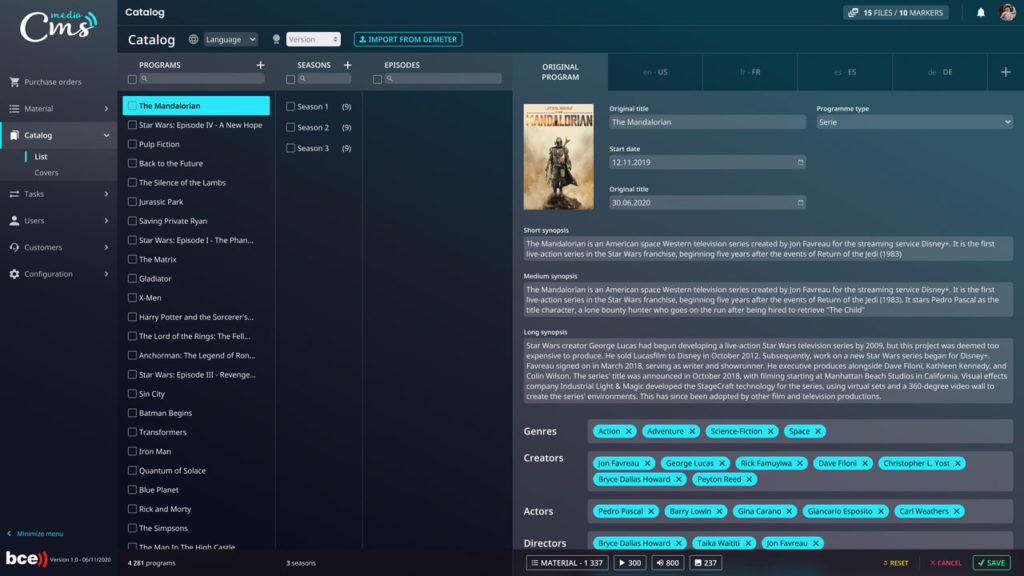Addressing the rising demand



With the massive shift from television to digital media, the broadcast industry future was set to decline. But broadcasters evolved, adapting to the new digital world, and shifting from “TV” to “Screen” broadcasting.
Continuously innovating and delivering new solution for the media world, Broadcasting Center Europe (BCE) gives an overview of the industry and describes, in three episodes, how it managed to tackle the market with solutions answering both the linear and non-linear video worlds.
On one hand, changing the mindset to “Screen” broadcasting opens wide horizons for the broadcast market development, according to The Business Research Company, the global broadcasting market is expected to grow at a CAGR of 5.5% from 2021 and reach 7,217.0 billion € in 2023. On the other hand, it engages the broadcasters to constantly renew their offer and innovate to match the continuously evolving OTT market.
As a matter of fact, OTT (Over-the-top) no longer stands for replay platforms only, it now includes streaming portals, social networks and applications which enrich the viewers’ experience. The live cast of linear television is not enough anymore, and the viewers are expecting more quality and timeless information as well as customized experiences and programs.
The technology shift, with state-of-the-art computers, powerful consumer smartphones and 5G connectivity, drives this content multiplication, giving the possibility to viewers to consume video content anywhere and at any moment. To answer this massive demand, broadcasters need to turn to advanced content management systems as well as automated solutions to create more content, but also to promote their formats on multiple screens.

“While our customers perfectly understand the importance of producing and buying more programs, video repurposing plays a key role in creating more content while ensuring the financial viability of their channels and OTT platforms” underlines Steven Dehaen, Program Supervision and Playout Manager at BCE.
With DVR (Digital Video Recorder), live DVR and Live to VOD solutions, channels can provide to their viewers other ways to consume their content. As a matter of fact, it allows linear and nonlinear replay of videos. Since viewers do not consume video programs the same way on social networks as they would on their 4K screens at home, tailoring the content to the digital platform is essential. With the appropriate content management system (CMS), channels can easily access this content, distribute the videos among their replay platforms or linear loop or even re-use the content to create new formats, matching the type of screen and target.
With BCE’s MediaCMS, users can easily access and manage their content. The solution is linked to the ingest platforms, as well as the recorders and live to VOD systems. It is crucial for the users to be able to retrieve the videos in the most effective way, to enrich live programs or to upload the appropriate videos following a targeted event, such as breaking News or Sports results. With an intelligent metadata workflow, the user can identify immediately the right content, modify the format, send to the postproduction for fast editing, distribute among its partners as well as publish it online, reducing drastically the time-to-air.
“Our solutions are all build as modules, which can communicate between each other. To enrich the metadata database, we can plug in a solution which will automatically identify precise items in a video, such as sponsors logos, and immediately add this reference to the metadata,” explains Stéphanie Schaeffer, Sales Account Officer at BCE. “More than smart modules, the users can create their own workflows within MediaCMS. At BCE, the solution communicates with the Digital Media Operations department, allowing the scheduling of complex transcoding tasks, subtitles integration, audio dubbing, graphics translation and enrichment, and much more.” Adds Stéphanie Schaeffer.


In a logic of content multiplication, it is also important to integrate the promotional aspect of all these programs. To be able to respond clearly to the broadcasting strategy of its customers’ messages on all screens, the broadcaster must be able to optimize the promos and trailers production workflows.
To that end, BCE’s solution ClipUp automates the complete promo and trailer production. With the integration of the channel branding, the metadata from the traffic systems and soundtracks, the solution automatically creates promos and trailers which match the broadcasting schedules as well as the OTT platforms formats. In addition, the solution can be integrated with any major editing station, allowing the producers to easily trigger rendering sessions.
Linked to the MediaCMS, the customer can easily upload its promos and trailers to streaming platforms, social networks, websites to create cross campaigns between linear and nonlinear environments. More screens mean a significant market penetration increase, giving a global footprint to media players. To ensure this internationalization, it is important to consider the addition of audio layers and subtitles or even customize the titles of the programs to other markets.
“Using our PaaS (Platform as a Service), Start and Play, for the broadcast to the EMEA and USA regions, SECOM is able to integrate multiple audio layers to match the needs of their viewers, allowing them to reach a broader audience with a single broadcast.” Explains Steven Dehaen.
“Content management is clearly in the heart of the new broadcast world. It allows the complex management of multiple types of items as well as numerous types of platforms, while keeping a cost-effective strategy and ensuring content multiplication to federate the users on the screens covered by the new media players. Live plays a strong part in both linear and non-linear broadcast as well and we have perfectly integrated this dimension in today’s connected and remote world.” Concludes Stéphanie Schaeffer.